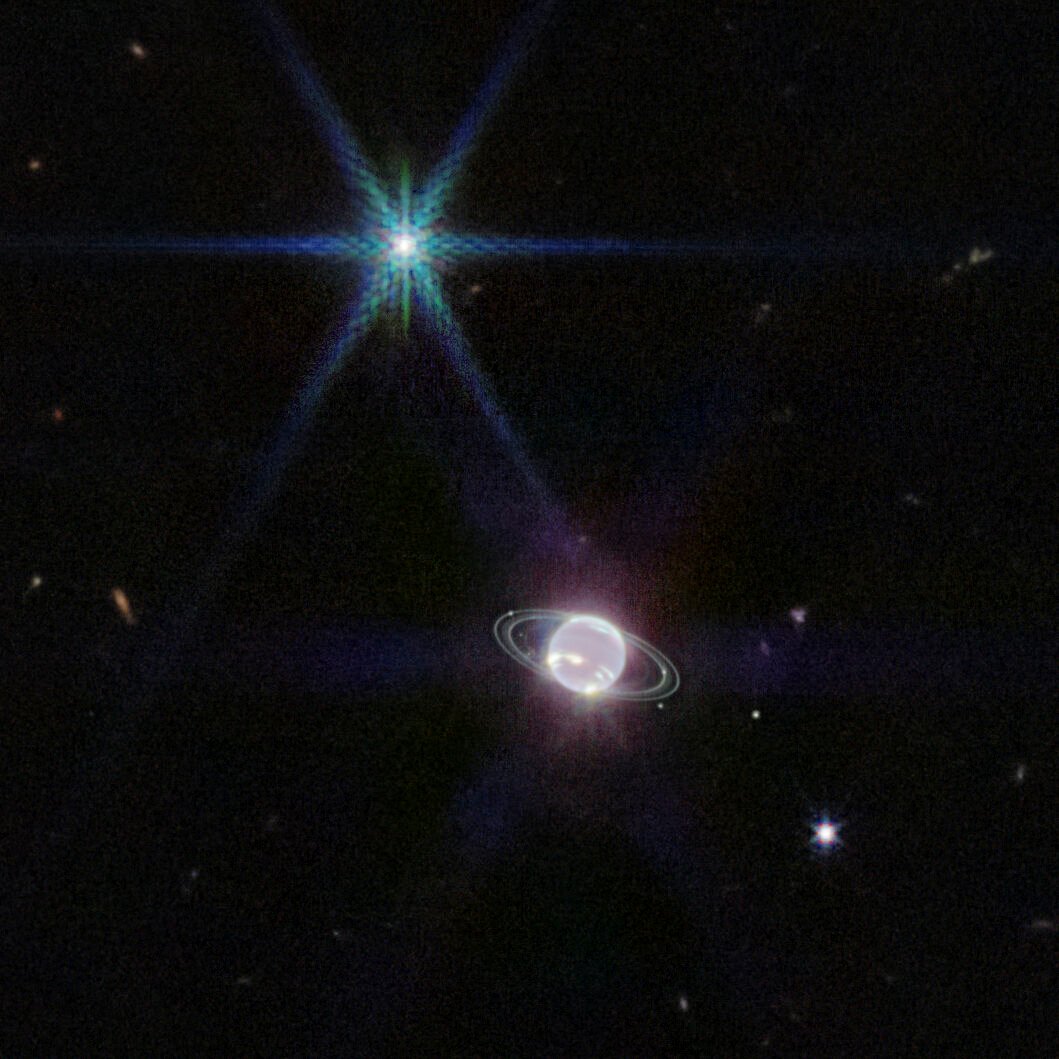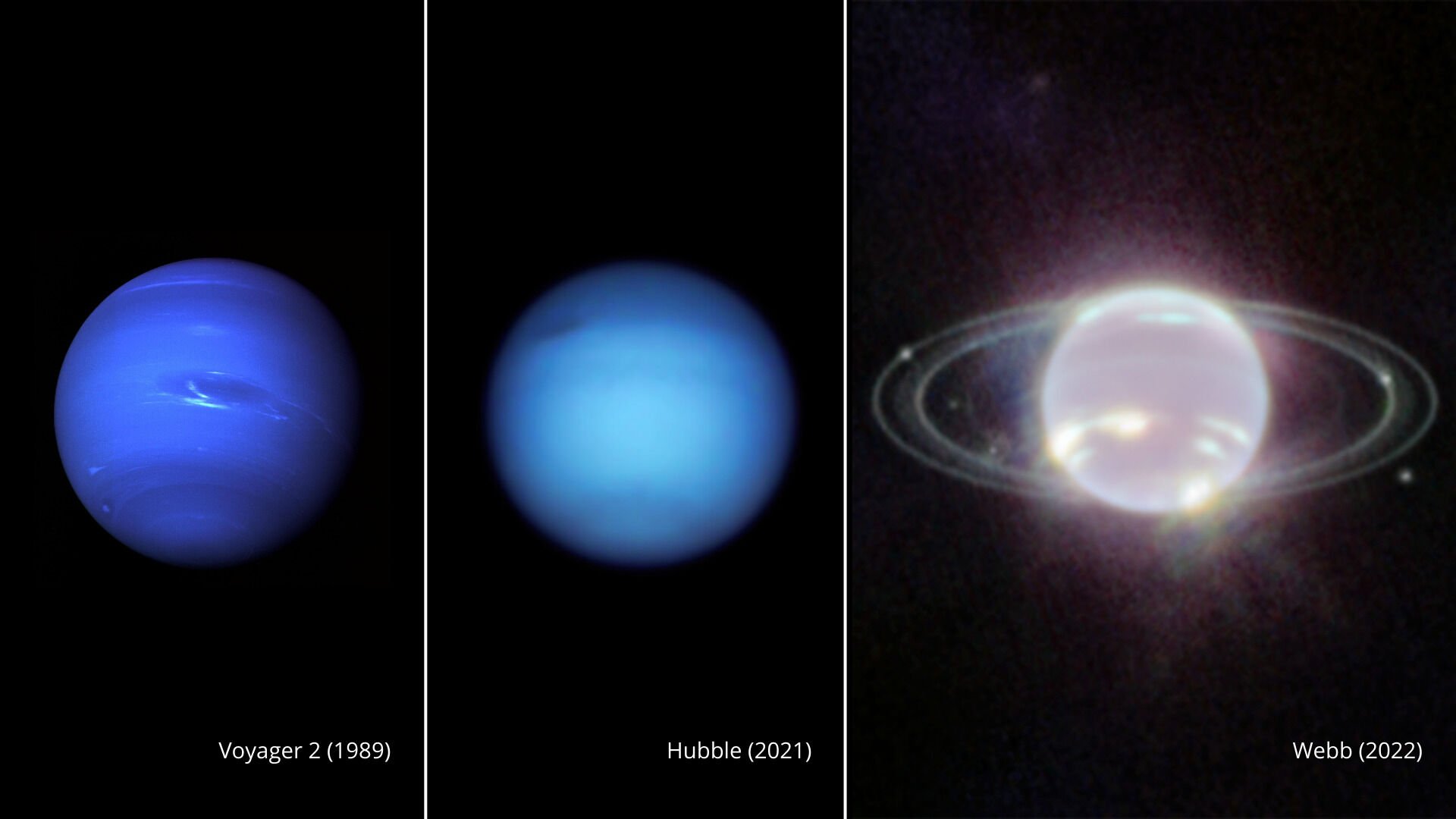
HOGP
This image provided by NASA on Wednesday, Sept. 21, 2022, shows the Neptune system captured by Webb’s Near-Infrared Camera, revealing the planet’s rings, which have not been seen with this clarity in more than three decades. Webb’s new image of Neptune also captures details of the planet’s turbulent, windy atmosphere. (NASA, ESA, CSA, STScI via AP)
CAPE CANAVERAL, Fla. (AP) — Neptune and its rings haven’t looked this good in decades.
NASA released new glamour shots of our solar system’s outermost planet Wednesday taken by the James Webb Space Telescope. The pictures taken in July show not only Neptune’s thin rings, but its faint dust bands, never before observed in the infrared, as well as seven of its 14 known moons.
Webb showed Jupiter at its best in a series of fresh photos released last month.
Launched less than a year ago, the $10 billion Webb is spending most of its time peering much deeper into the universe. Astronomers hope to see back to almost the beginning of time when the first stars and galaxies were forming.
NASA’s Voyager 2 was the first spacecraft to see Neptune in all its gaseous glory, during a 1989 flyby. No other spacecraft have visited the icy, blue planet. So it’s been three decades since astronomers last saw these rings with such detail and clarity, said the Space Science Institute’s Heidi Hammel, a planetary astronomer working with Webb.
Hammel tweeted that she wept when she saw the rings, yelling and making “my kids, my mom, even my cats look.”
Webb is the world’s biggest, most powerful telescope, operating 1 million miles (1.6 million kilometers) from Earth. It rocketed into space last December.

HOGP
This composite image provided by NASA on Wednesday, Sept. 21, 2022, shows three side-by-side images of Neptune. From left, a photo of Neptune taken by Voyager 2 in 1989, Hubble in 2021, and Webb in 2022. In visible light, Neptune appears blue due to small amounts of methane gas in its atmosphere. Webb’s Near-Infrared Camera instead observed Neptune at near-infrared wavelengths, where Neptune resembles a pearl with thin, concentric oval rings. (NASA, ESA, CSA, STScI via AP)
The observatory is in good health, according to NASA, except for one item.
NASA reported this week that a mechanism on one of Webb’s instruments showed signs of increased friction late last month in one of four observing modes. Observations are on hold in this one particular observing track, as a review board decides on a path forward.
-
James Webb telescope shows it’s possible to seek alien life in distant planets’ atmospheres
NASA/ESA/CSA/STScI via AP
This image provided by NASA on Monday, July 11, 2022, shows galaxy cluster SMACS 0723, captured by the James Webb Space Telescope. The telescope is designed to peer back so far that scientists can get a glimpse of the dawn of the universe about 13.7 billion years ago and zoom in on closer cosmic objects, even our own solar system, with sharper focus.
NASA/ESA/CSA/STScI via AP
This image provided by NASA on Monday, July 11, 2022, shows galaxy cluster SMACS 0723, captured by the James Webb Space Telescope. The telescope is designed to peer back so far that scientists can get a glimpse of the dawn of the universe about 13.7 billion years ago and zoom in on closer cosmic objects, even our own solar system, with sharper focus.
-
James Webb telescope shows it’s possible to seek alien life in distant planets’ atmospheres
NASA, ESA, CSA, and STScI via AP
This combo of images provided by NASA on Tuesday, July 12, 2022, shows a side-by-side comparison of observations of the Southern Ring Nebula in near-infrared light, at left, and mid-infrared light, at right, from the Webb Telescope.
NASA, ESA, CSA, and STScI via AP
This combo of images provided by NASA on Tuesday, July 12, 2022, shows a side-by-side comparison of observations of the Southern Ring Nebula in near-infrared light, at left, and mid-infrared light, at right, from the Webb Telescope.
-
-
James Webb telescope shows it’s possible to seek alien life in distant planets’ atmospheres
NASA, ESA, CSA, STScI via AP
This image released by NASA on Tuesday, July 12, 2022, shows the bright star at the center of NGC 3132 for the first time in near-infrared light.
NASA, ESA, CSA, STScI via AP
This image released by NASA on Tuesday, July 12, 2022, shows the bright star at the center of NGC 3132 for the first time in near-infrared light.
-
James Webb telescope shows it’s possible to seek alien life in distant planets’ atmospheres
NASA, ESA, CSA, and STScI via AP
This image provided by NASA on Tuesday, July 12, 2022, shows Stephan's Quintet, a visual grouping of five galaxies, as observed from the Webb Telescope. This mosaic was constructed from almost 1,000 separate image files, according to NASA.
NASA, ESA, CSA, and STScI via AP
This image provided by NASA on Tuesday, July 12, 2022, shows Stephan's Quintet, a visual grouping of five galaxies, as observed from the Webb Telescope. This mosaic was constructed from almost 1,000 separate image files, according to NASA.
-
-
James Webb telescope shows it’s possible to seek alien life in distant planets’ atmospheres
NASA, ESA, CSA, and STScI via AP
This image provided by NASA on Tuesday, July 12, 2022, shows Stephan's Quintet, a visual grouping of five galaxies captured by the Webb Telescope's Mid-Infrared Instrument (MIRI).
NASA, ESA, CSA, and STScI via AP
This image provided by NASA on Tuesday, July 12, 2022, shows Stephan's Quintet, a visual grouping of five galaxies captured by the Webb Telescope's Mid-Infrared Instrument (MIRI).
-
James Webb telescope shows it’s possible to seek alien life in distant planets’ atmospheres
NASA, ESA, CSA, and STScI via AP
-
-
James Webb telescope shows it’s possible to seek alien life in distant planets’ atmospheres
NASA, ESA, CSA, and STScI via AP
This image released by NASA on Tuesday, July 12, 2022, shows the edge of a nearby, young, star-forming region NGC 3324 in the Carina Nebula. Captured in infrared light by the Near-Infrared Camera (NIRCam) on the James Webb Space Telescope, this image reveals previously obscured areas of star birth, according to NASA.
NASA, ESA, CSA, and STScI via AP
This image released by NASA on Tuesday, July 12, 2022, shows the edge of a nearby, young, star-forming region NGC 3324 in the Carina Nebula. Captured in infrared light by the Near-Infrared Camera (NIRCam) on the James Webb Space Telescope, this image reveals previously obscured areas of star birth, according to NASA.
-
James Webb telescope shows it’s possible to seek alien life in distant planets’ atmospheres
NASA, ESA, CSA, STScI via AP
This image released by NASA on Tuesday, July 12, 2022, combined the capabilities of the James Webb Space Telescope's two cameras to create a never-before-seen view of a star-forming region in the Carina Nebula. Captured in infrared light by the Near-Infrared Camera (NIRCam) and Mid-Infrared Instrument (MIRI), this combined image reveals previously invisible areas of star birth.
NASA, ESA, CSA, STScI via AP
This image released by NASA on Tuesday, July 12, 2022, combined the capabilities of the James Webb Space Telescope's two cameras to create a never-before-seen view of a star-forming region in the Carina Nebula. Captured in infrared light by the Near-Infrared Camera (NIRCam) and Mid-Infrared Instrument (MIRI), this combined image reveals previously invisible areas of star birth.


